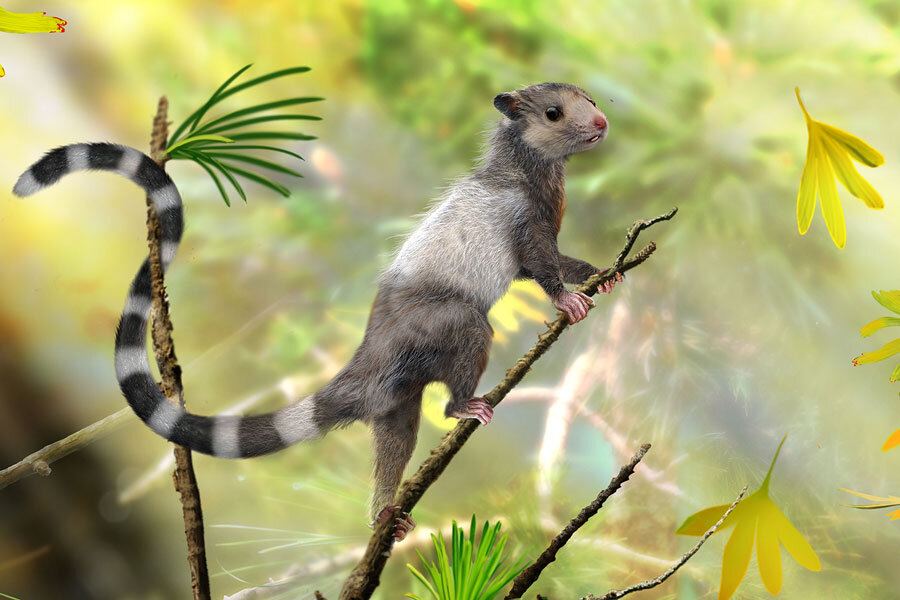Jurassic 'squirrels' push back clock on emergence of mammals
The fossil remains of squirrel-like mammals with a hefty dose of cute are helping reset the clock for mammalian evolution, according to a new study.
Over the past three years, a team of researchers has uncovered six 160-million-year-old fossils that represent three new species who were living in trees at the time of the dinosaurs.
In placing these creatures along the mammal family tree, the researchers conclude that mammals emerged and exploded in diversity between 235 million and 201 million years ago, during the Triassic period. If the results hold up to additional scrutiny, they imply a much earlier start for mammals than some previous studies had indicated. They also dovetail with DNA studies that have pointed to an earlier emergence for mammals.
Combined with other mammal fossils from the early Jurassic, which began about 200 million years ago, the results also reinforce the notion that mammals were more than Lilliputian interlopers timidly eking out a living under the shadow of mighty dinosaurs. Instead, they were a thriving group. Some could swim, some could dig, suggesting a land-based habitat. Along come these new specimens whose bodies are well adapted to living in the canopy of Jurassic forests.
The specimens came from two sites in northeastern China's Liaoning Province, one of which was a rock outcrop in the middle of a corn field, says Jin Meng, curator of the paleontology division at the American Museum of Natural History in New York and a member of the team reporting the results in Thursday's issue of the journal Nature.
The fossils for the three species, grouped together in a new clade called euharamiyida, were remarkably preserved, with most of the bones still in place. Based on their skeletal structures, the creatures weighed a scant 1 to 10 ounces, the researchers estimate. They had long, segmented tails, delicate bone structures, and long fingers and toes that, along with the tail, would have been useful in clinging to tree branches, the researchers say. Members of this group probably ate insects, nuts, and fruit.
"The living animals we can compare them with are squirrels," Dr. Meng says, adding that these specimens present "perhaps the most convincing evidence showing that many Mesozoic mammals are arboreal."
"Jurassic mammals are much more diverse than we thought before," he says.
The team has named the three species Shenshou lui, Xianshou songae, and Xianshou linglong.
The finds' real importance rests in what these fossils have to say about the timing for the divergence of mammals from reptiles, the researchers say.
The story begins some 170 years ago, when naturalists found fossil molars in rock formations in England that turned out to be from the late Triassic. Scientists assigned the animal that sported the teeth to a new group called haramiyida.
The molars were mammal-like, and were quite similar to those of members of another group, the multituberculata, rodent-like creatures generally recognized as being mammals. This group eventually grew to include at least 200 species. By many accounts, its nearly 120-million-year run on planet Earth – surviving the global catastrophe that doomed the dinosaurs – makes them the most enduring group of mammals in Earth's history.
The similarity between the teeth of the two groups led some researchers to argue that haramiyida were mammals. But with no ability to compare skeletal features between the two, it was hard to say if haramiyida truly fit into the mammal category. Some scientists argued that these should be placed outside of mammals on the evolutionary tree.
In essence, "there was too little information" to make the call, Meng says.
The debate has a direct bearing on dating the emergence of mammals because the haramiyida are substantially older than the multituberculata.
Meng and his colleagues have uncovered the first complete skeletons which they say better represents this group – so much so that they in effect put their finds into a new group, euharamiyida, or true haramiyida. They include in this group some of the previous finds that had been assigned to haramiyida.
"We provide very convincing evidence of what the animal really looked like in addition to their teeth," Meng says, adding that most of the skeletal forms seen in the fossils are mammalian. Moreover, the skeletons are similar to those of multituberculata as well as to other mammals.
Indeed, the team, led by Shundong Bi, a researcher with the Chinese Academy of Sciences in Beijing, see multituberculata and euharamiyida as sister groups that share the earliest haramiyida as common mammalian ancestors.







